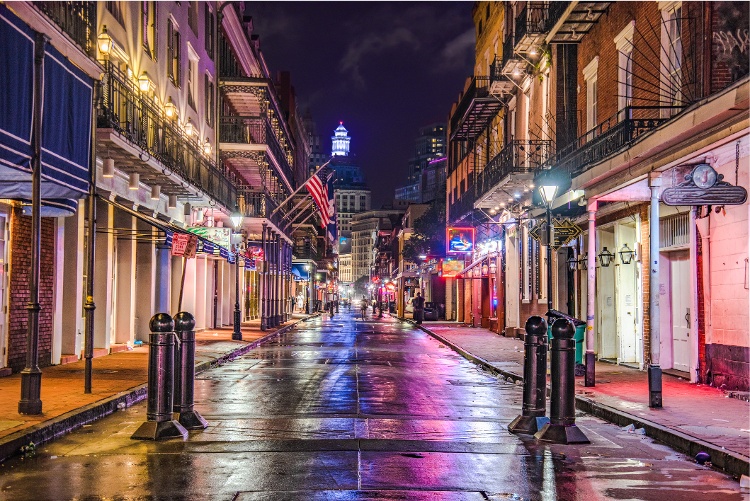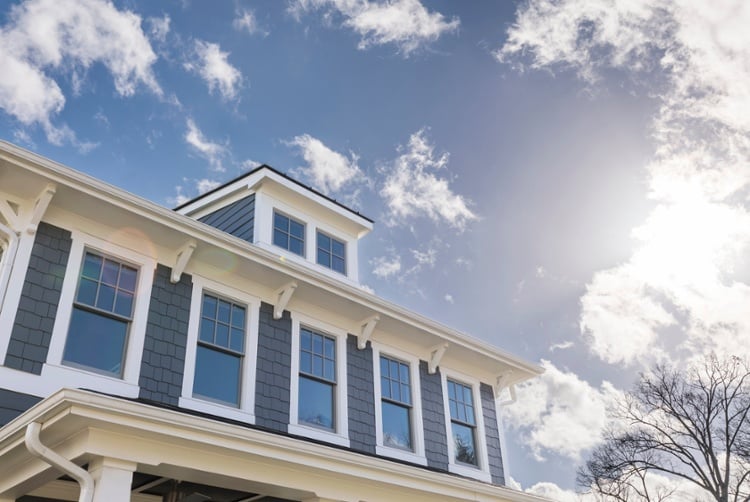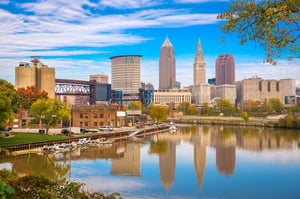As a real estate investor, you want to find properties where your investment dollar will go the furthest.
To help you do that, we decided to compile a list of the cheapest states to buy a house in America in 2022. We analyzed data from several sources:
- Zillow Research for home values and historic price trends (as of March 2022)
- GOBankingRates for average rent of a 3-bedroom place
- Yahoo to find the cheapest cities to buy a home
- World Population Review to determine the current cost of living index for each state
Note: The following data is on a state level and will naturally vary by market within each state.
→View investment properties listed under $100K on our marketplace
1. West Virginia
West Virginia is home to just under 1.8 million people and is the 40th-most populated state in the U.S. Largest industries in West Virginia include tourism and natural resources. Charleston is the state capital and Huntington-Ashland is the largest metropolitan area.
- Median home value: $130,625 (Zillow)
- 1-year price change: 13.2% (Zillow)
- 5-year price change: 32.0% (Zillow)
- Average rent: $912 (GOBankingRates)
- Cheapest cities to buy a house: Bluefield, Clarksburg, Beckley, Huntington (Yahoo)
- Cost of living index: 91.1 (World Population Review)
2. Mississippi
Mississippi is the 34th-most populous state in the U.S. and home to nearly 3 million residents. Agriculture and manufacturing are two of the largest industries in the state. Jackson is the state capital and also the largest metro area in Mississippi.
- Median home value: $159,955
- 1-year price change: 15.0%
- 5-year price change: 37.5%
- Average rent: $989
- Cheapest cities to buy a house: Jackson, Greenville, Meridian, Gulfport
- Cost of living index: 86.1
>> Browse Mississippi investment properties
3. Arkansas
Home to more than 3 million people, Arkansas is the 33rd-largest state in the U.S. Agriculture, manufacturing, and tourism help drive the economy in Arkansas. Little Rock is the capital city and also the biggest metropolitan area.
- Median home value: $172,306
- 1-year price change: 18.0%
- 5-year price change: 45.5%
- Average rent: $926
- Cheapest cities to buy a house: Pine Bluff, Texarkana, North Little Rock, Fort Smith
- Cost of living index: 86.9
>> Browse Arkansas investment properties
4. Oklahoma
Oklahoma has a population of almost 4 million people and is the 28th-most populated state in the U.S. The diverse economy is powered by the agriculture, manufacturing, and natural resource sectors. Oklahoma City is the state capital and the biggest metro area.
- Median home value: $173,410
- 1-year price change: 17.2%
- 5-year price change: 43.3%
- Average rent: $1,015
- Cheapest cities to buy a house: Muskogee, Lawton, Shawnee, Enid
- Cost of living index: 87.0
>> Browse Oklahoma investment properties
5. Iowa
Home to more than 3.1 million people, Iowa is the 31st-most populous state in the U.S. The diverse economy is driven by the manufacturing, information and biotechnology, agriculture, and natural resource sectors. Des Moines is the state capital and Omaha Bluffs is the biggest metropolitan area.
- Median home value: $184,972
- 1-year price change: 12.0%
- 5-year price change: 32.0%
- Average rent: $1,021
- Cheapest cities to buy a house: Waterloo, Sioux City, Davenport, Council Bluffs
- Cost of living index: 90.1
6. Kentucky
Kentucky is the 26th-largest state in the U.S. with over 4.5 million people. Agriculture, manufacturing, healthcare, and natural resources help keep the economy strong. Frankfort is the state capital and Louisville is the largest metro area.
- Median home value: $190,575
- 1-year price change: 15.2%
- 5-year price change: 47.3%
- Average rent: $1,025
- Cheapest cities to buy a house: Hopkinsville, Covington, Owensboro, Bowling Green
- Cost of living index: 90.9
>> Browse Kentucky investment properties
7. Alabama
Just over 5 million people reside in Alabama, making the state the 24th-largest in the U.S. The diverse economy of Alabama is driven in part by the agriculture, manufacturing, healthcare, and financial sectors. Montgomery is the state capital and Birmingham is the largest metro area.
- Median home value: $197,667
- 1-year price change: 18.4%
- 5-year price change: 51.2%
- Average rent: $1,060
- Cheapest cities to buy a house: Gadsden, Birmingham, Montgomery, Phenix City
- Cost of living index: 89.3
>> Browse Alabama investment properties
8. Kansas
Kansas is the 35th-most populated state in the U.S. and home to almost 3 million people. Agriculture, natural resources, and manufacturing help drive the Kansas economy. Topeka is the capital city and Kansas City is the biggest metropolitan area.
- Median home value: $199,893
- 1-year price change: 13.4%
- 5-year price change: 43.3%
- Average rent: $1,050
- Cheapest cities to buy a house: Hutchinson, Kansas City, Topeka, Salina
- Cost of living index: 89.0
>> Browse Kansas investment properties
9. Ohio
Another Midwest state on the list, Ohio is the 7th largest state in the U.S. and home to nearly 12 million residents. Manufacturing and financial services are the two largest sectors of the economy. Columbus is the state capital and Cincinnati is the largest metro area.
- Median home value: $202,341
- 1-year price change: 15.5%
- 5-year price change: 54.7%
- Average rent: $1,024
- Cheapest cities to buy a house: Youngstown, Warren, Dayton, Marion
- Cost of living index: 90.8
>> Browse Ohio investment properties

10. Louisiana
Louisiana is the 25th-most populated state in the U.S. with almost 4.7 million residents. Agriculture, transportation, and tourism are three of the largest business sectors in Louisiana. Baton Rouge is the state capital and New Orleans is the largest metro area.
- Median home value: $208,049
- 1-year price change: 12.5%
- 5-year price change: 25.4%
- Average rent: $988
- Cheapest cities to buy a house: Shreveport, Alexandria, Monroe, Marrero
- Cost of living index: 93.9
11. Indiana
Indiana is home to nearly 6.8 million residents and is the 17th-largest state in the U.S. The economy is driven by the manufacturing, agriculture, and healthcare sectors. Indianapolis is the state capital and also the biggest metropolitan area.
- Median home value: $212,953
- 1-year price change: 17.7%
- 5-year price change: 59.3%
- Average rent: $1,052
- Cheapest cities to buy a house: Gary, Anderson, Muncie, Richmond
- Cost of living index: 90.0
>> Browse Indiana investment properties
12. Missouri
Missouri is the 19th-most populated state in the U.S. and home to more than 6.1 million people. Major industries include aerospace, transportation, manufacturing, and financial services. Jefferson City is the state capital and St. Louis is the largest metro area.
- Median home value: $221,446
- 1-year price change: 16.4%
- 5-year price change: 51.0%
- Average rent: $1,086
- Cheapest cities to buy a house: St. Joseph, Florissant, Joplin, Independence
- Cost of living index: 87.1
>> Browse Missouri investment properties
13. Michigan
Michigan is home to over 10 million residents and the 10th-most populated state in the U.S. The state’s diverse economy is driven by the manufacturing, natural resources, defense, and information technology sectors. Lansing is the state capital and Detroit is the biggest metropolitan area.
- Median home value: $228,120
- 1-year price change: 16.0%
- 5-year price change: 57.9%
- Average rent: $1,140
- Cheapest cities to buy a house: Flint, Detroit, Bay City, Saginaw
- Cost of living index: 88.9
>> Browse Michigan investment properties
14. Nebraska
With nearly 2.0 million residents, Nebraska is the 37th-largest state in the U.S. Agriculture, transportation, manufacturing, and information technology help drive the state’s economy. Lincoln is the state capital and Omaha-Council Bluffs is the biggest metropolitan area.
- Median home value: $233,006
- 1-year price change: 13.9%
- 5-year price change: 49.0%
- Average rent: $1,103
- Cheapest cities to buy a house: Beatrice, Lexington, Hastings, Scottsbluff
- Cost of living index: 90.8
15. Wisconsin
Nearly 6 million people reside in Wisconsin, making the state the 20th-largest in the U.S. Major industries such as agriculture, manufacturing, and consumer goods drive the economy. Madison is the state capital and Milwaukee is the largest metropolitan area.
- Median home value: $254,680
- 1-year price change: 14.0%
- 5-year price change: 50.8%
- Average rent: $1,133
- Cheapest cities to buy a house: Beloit, Manitowoc, Racine, Fond du Lac
- Cost of living index: 97.3
>> Browse Wisconsin investment properties
16. Illinois
About 12.8 million people live in Illinois, making the state the 6th-largest in the U.S. Agriculture, manufacturing, finance and investment, and the service sectors keep the diverse economy growing. Springfield is the capital city and Chicago is the largest metropolitan area.
- Median home value: $256,010
- 1-year price change: 14.2%
- 5-year price change: 32.9%
- Average rent: $1,240
- Cheapest cities to buy a house: Danville, Galesburg, Decatur, Peoria
- Cost of living index: 94.5
>> Browse Illinois investment properties
17. Pennsylvania
Home to over 13 million residents, Pennsylvania is the 5th-largest state in the U.S. Finance and agriculture are the two largest industries in the state. Harrisburg is the capital city and Philadelphia/Delaware Valley is the largest metro area.
- Median home value: $257,272
- 1-year price change: 14.5%
- 5-year price change: 46.3%
- Average rent: $1,154
- Cheapest cities to buy a house: Harrisburg, Wilkes-Barre, Altoona, Scranton
- Cost of living index: 101.7
>> Browse Pennsylvania investment properties
18. North Dakota
The population of North Dakota is about 780,000 making it the 3rd-smallest state. Agriculture is the largest industry in North Dakota, followed by petroleum, food processing, and technology. Bismarck is the state capital and Fargo is the largest metropolitan area.
- Median home value: $268,918
- 1-year price change: 9.4%
- 5-year price change: 16.8%
- Average rent: $1,190
- Cheapest cities to buy a house: Jamestown, Minot, Grand Forks, Fargo
- Cost of living index: 98.8
19. South Carolina
South Carolina is the 23rd-most populated state in the U.S. and home to over 5.1 million people. Agriculture, manufacturing, and healthcare are three of the largest industries in South Carolina. Columbia is the state capital and Greenville-Anderson is the largest metro area.
- Median home value: $274,401
- 1-year price change: 24.9%
- 5-year price change: 58.9%
- Average rent: $1,115
- Cheapest cities to buy a house: Sumter, Spartanburg, Florence, Columbia
- Cost of living index: 95.9
>> Browse South Carolina investment properties
20. New Mexico
New Mexico is the 36th-most populated state in the U.S. and home to over 2.1 million people. About one-half of its economy is based on the service sector, while much of the remainder is centered on extractive industries (mining and oil production). Santa Fe is the state capital and Albuquerque is the biggest metro area.
- Median home value: $281,938
- 1-year price change: 19.1%
- 5-year price change: 55.8%
- Average rent: $1,134
- Cheapest cities to buy a house: Roswell, Alamogordo, Farmington, Clovis
- Cost of living index: 87.5
21. South Dakota
With just under 890,000 residents, South Dakota is the 4th-smallest state in the U.S. Agriculture and service sectors such as retail, finance, and healthcare drive the economy. Pierre is the state capital and Sioux Falls is the largest metro area.
- Median home value: $282,226
- 1-year price change: N/A
- 5-year price change: 48.3%
- Average rent: $979
- Cheapest cities to buy a house: Huron, Mitchell, Aberdeen, Vermillion
- Cost of living index: 99.8
22. Tennessee
Nearly 7 million people live in Tennessee, making the state the 16th-largest in the U.S. Major industries include automotive manufacturing, agriculture and textiles, and energy. Nashville is the capital city and also the biggest metropolitan area.
- Median home value: $282,592
- 1-year price change: 26.3%
- 5-year price change: 72.1%
- Average rent: $1,121
- Cheapest cities to buy a house: Memphis, Jackson, Kingsport, Johnson City
- Cost of living index: 88.7
>> Browse Tennessee investment properties
23. Texas
Texas is the 2nd-largest state by population in the U.S. with nearly 29.2 million residents. Major industries in Texas include agriculture and mining, energy and natural resources, and technology. Austin is the state capital and Dallas-Fort Worth is the largest metro area.
- Median home value: $295,319
- 1-year price change: 24.1%
- 5-year price change: 56.4%
- Average rent: $1,289
- Cheapest cities to buy a house: Port Arthur, Wichita Falls, Brownsville, Pharr
- Cost of living index: 91.5
>> Browse Texas investment properties
24. Georgia
Georgia is the 8th-most populated state in the U.S. and home to more than 10.7 million people. The diverse economy is driven by the agriculture and mining, industry and logistics, and defense sectors. Atlanta is the state capital and also the largest metropolitan region in Georgia.
- Median home value: $300,885
- 1-year price change: 27.3%
- 5-year price change: 73.4%
- Average rent: $1,179
- Cheapest cities to buy a house: Albany, Macron, Columbus, Augusta
- Cost of living index: 89.2
>> Browse Georgia investment properties
25. North Carolina
North Carolina is the 9th-most populated state in the U.S. and home to over 10.4 million people. Agriculture, textiles and manufacturing, and high technology help drive the state’s diverse economy. Raleigh is the state capital and Charlotte is the biggest metro area.
- Median home value: $302,153
- 1-year price change: 26.6%
- 5-year price change: 68.3%
- Average rent: $1,140
- Cheapest cities to buy a house: Rocky Mount, Fayetteville, Wilson, Burlington
- Cost of living index: 94.9
>> Browse North Carolina investment properties
Macro trends to watch in 2022
The housing market in 2021 was characterized by low interest rates with more demand than supply. Will next year be more of the same, or something completely different?
While there’s no such thing as a crystal ball, there are several macro trends that investors can monitor to help predict how the housing market will perform in 2022:
- Continued migration of people to the suburbs and smaller secondary and tertiary markets, as the COVID-19 pandemic normalized work-from-home.
- Monetary policy and the effect on mortgage interest rates.
- Economic growth and gross domestic product.
- Consumer confidence and changes in the job market.
- Average median home price and affordability.
- Existing and new home sales.
- Homeownership vs. renter-occupied rate.
- Single-family housing starts and overall supply of housing.
- Markets that make sense for real estate investing.
Ready to invest in one of these top 25 cheapest states to buy a home? If you haven't already done so, create your free Roofstock account and set up alerts. We'll notify you when we have an investment property that matches your search criteria.









